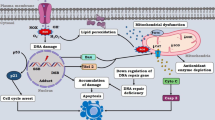Abstract
Ionizing radiation, especially gamma (γ) radiation, is assumed to be very effective for DNA damage due to formation of free radicals. DNA damage and inhibition of DNA damage produced on irradiation with 60Co gamma source were characterized by fluorescence spectrometry. Reduced form of glutathione (GSH) and its novel molybdenum glutathione (MoG) complex were employed for the protection of γ-radiation induced DNA damage. The spectroscopic results of the present study showed that the MoG complex is more efficient in protecting the double stranded DNA in vitro compared to reduced form of GSH.






Similar content being viewed by others
References
Jamali MAA, Batist G, Lehnert S (1992) Radiation-induced damage to DNA in drug and radiation-resistant sublines of a human breast cancer cell line. Radiat Res 129:37–42
Boloor KK, Kamat JP, Devasagayam TP (2000) Chlorophyllin as a protector of mitochondrial membranes against gamma-radiation and photosensitization. Toxicol 155:63–71
Santivasi WL, Xia F (2014) Ionizing radiation-induced DNA damage, response, and repair. Antioxid Redox Signal 21:251–259
Sankaranarayanan K, Taleei R, Rahmanian S, Nikjoo H (2013) Ionizing radiation and genetic risks. XVII. Formation mechanisms underlying naturally occurring DNA deletions in the human genome and their potential relevance for bridging the gap between induced DNA double-strand breaks and deletions in irradiated germ cells. Mutat Res 753:114–130
Sophie LC (2011) Water radiolysis: influence of oxide surfaces on H2 production under ionizing radiation. Water 3:235–253
Velpula N, Ugrappa S, Kodangal S (2013) A role of radioprotective agents in cancer therapeutics: a review. Int J Basic Clin Pharmacol 2:677–682
Demple B, Harrison L (1994) Repair of oxidative damage to DNA. Annu Rev Biochem 63:915–948
Kumar SS, Chaubey RC, Devasagayam TPA, Priyadarsini KI, Chauhan PS (1999) Inhibition of radiation-induced DNA damage in plasmid pBR322 by chlorophyllin and possible mechanism (s) of action. Mutat Res 425:71–79
Rajagopalan R, Wani K, Huilgol NG, Kagiya TV, Nair CK (2002) Inhibition of gamma radiation Induced DNA damage in plasmid pBR322 by TMG, a water-soluble derivative of vitamin E. J Radiat Res 43:153–159
Hutchinson F (1985) Chemical changes induced in DNA by ionizing radiation. Prog Nucl Acid Res Mol Biol 32:115–154
Dizdaroglu M (1992) Oxidative damage to DNA in mammalian chromatin. Mutat Res 275:331–342
Sonntag CV (2005) Free radical induced DNA damage and its repair, a chemical perspective. Springer, Berlin
Venkatachalam SR, Chattopadhyay S (2005) Natural radioprotective agents: an overview. Curr Org Chem 9:389–404
Shimizu T, Iwanaya M, Yasunaga A, Urata Y, Goto S, Shibata S, Kondo T (1998) Protective role of glutathione synthesis on radiation-induced DNA damage in rabbit brain. Cell Mol Neurobiol 18:299–310
Sert C, Celik MS, Akdag Z, Ketani MA, Nergiz Y (2000) The radioprotective effect of vitamins C, E and vitamin E+ glutathione on the small intestine and the thyroid gland in rats irradiated with X-rays. Turk J Med Sci 30:417–426
Arima P, Shiba R (1992) Radioprotecyive effect of exogenous glutathione on rat parotid glands. Int J Radiat Biol 61:695–702
Badiello R, Ceschel GC, Esposito B (1998) Radioprotective effects of glutathione on molecular systems. J Radioanal Nucl Chem 229:149–152
Dannenmann B, Lehle S, Hildebrand DG, Kübler A, Grondona P, Schmid V, Holzer K, Fröschl M, Essmann F, Rothfuss O, Osthoff KS (2015) High glutathione and glutathione peroxidase-2 Levels mediate cell-type-specific DNA damage protection in human induced pluripotent stem cells. Stem Cell Rep 4:886–898
Chatterjee A (2013) Reduced glutathione: a radioprotector or a modulator of DNA-repair activity. Nutrients 5:525–542
Kim JK, Kim JH, Yoon YD (2003) Evaluation of caffeine as a radioprotector in whole-body irradiated male mice. In Vivo 17:197–200
Hussein MR, Abu-Dief EE, El-Ghait ATA, Adly MA, Abdelraheem MH (2006) Morphological evaluation of the radioprotective effects of melatonin against X-ray-induced early and acute testis damage in Albino rats: an animal model. Int J Exp Pathol 87(3):237–250
Taysi S, Koc M, Buyukokuroglu ME, Altinkaynak K, Sahin Y (2003) Melatonin reduces lipid peroxidation and nitric oxide during irradiation-induced oxidative injury in the rat liver. J Pineal Res 34:173–177
Paul SS, Selim M, Saha A, Mukherjea KK (2014) Synthesis and structural characterization of dioxomolybdenum and dioxotungsten hydroxamato complexes and their function in the protection of radiation induced DNA. Dalton Trans 43:2835–2848
L’vov NP, Nosikov AN, Antipov AN (2002) Tungsten-containing enzymes. Biochem 67:196–200
Schwarz G, Mendel RR, Ribbe MW (2009) Molybdenum cofactors, enzymes and pathways. Nature 460:839–847
Alikulov ZA, L’vov NP, Burikhanov SS, Kretovich VL (1980) Isolation of cofactor common to molybdenum-containing enzymes: nitrate reductase from lupine bacteroids and xanthine oxidase from milk. Biol Bull Acad Sci 7:379–384
Suh D (1999) Cooperative binding interaction of ethidium with allosteric DNA. Exp Mol Med 31:151–158
Reichmann MF, Rice SA, Thomas CA, Doty P (1954) A further examination of the molecular weight and size of desoxypentose nucleic acid. J Am Chem Soc 76:3047–3053
Selim M, Saha A, Mukherjea KK (2012) Synthesis, characterization, and DNA binding of the biologically relevant novel cationic molybdenum(VI)–glutathione complex [Mo(GS)(Cl)(H2O)]Cl2. Monat Chem 143:227–233
Held KD, Biaglow JE (1994) Mechanisms for the oxygen radical-mediated toxicity of various thiol-containing compounds in cultured mammalian cells. Radiat Res 139:15–23
Maisin BJR (1998) Bacq and Alexander award lecture chemical radioprotection: past, present and future prospects. Int J Radiat Biol 73:443–450
Maurya DK, Adhikari S, Nair CKK, Devasagayam TPA (2007) DNA protective properties of vanillin against γ-radiation under different conditions: Possible mechanisms. Mutat Res 634:69–80
Acknowledgments
The authors are thankful to UGC-DAE-CSR, Kolkata Centre for financial assistance to KKM in the form of Major Research Projects (UGC-DAE-CSR-KC/CRS/09/RC03/1456 and UGC-DAE-CSR-KC/CRS/13/RC05/088) where MS and SB are project fellows respectively. Authors also thank Jadavpur University for providing necessary facilities.
Author information
Authors and Affiliations
Corresponding author
Rights and permissions
About this article
Cite this article
Selim, M., Saha, A. & Mukherjea, K.K. Protection of radiation induced DNA damage by a newly developed molybdenum complex. J Radioanal Nucl Chem 311, 189–193 (2017). https://doi.org/10.1007/s10967-016-5061-5
Received:
Published:
Issue Date:
DOI: https://doi.org/10.1007/s10967-016-5061-5




